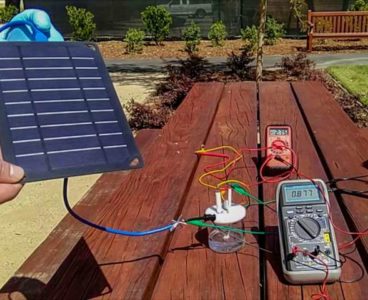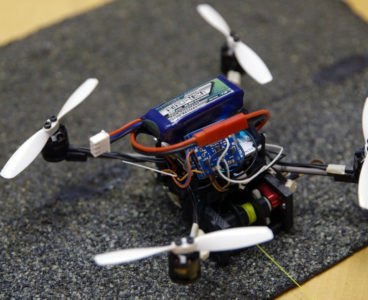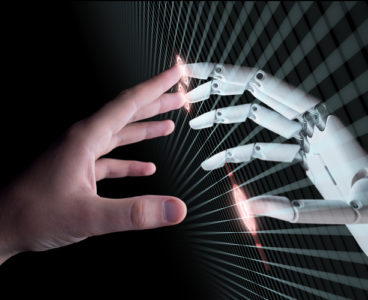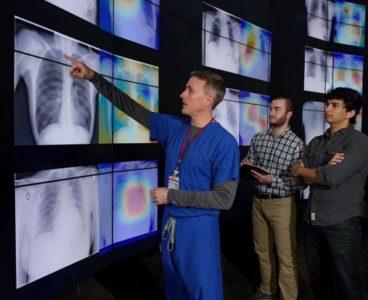If manufacturers of cell-phone batteries could tell which cells will last at least two years, then they could sell only those to phone makers and send the rest to makers of less demanding devices. New research shows how manufacturers could do this. The technique could be used not only to sort manufactured cells but to…
Researchers Create Hydrogen Fuel From Seawater
Stanford researchers have devised a way to generate hydrogen fuel using solar power, electrodes and saltwater from San Francisco Bay. The findings, published March 18 in Proceedings of the National Academy of Sciences, demonstrate a new way of separating hydrogen and oxygen gas from seawater via electricity. Existing water-splitting methods rely on highly purified water,…
Using Machine Learning, Research Team Tracks Solar Panel Installation in U.S.
Humans Help Robots Learn Tasks
In the basement of the Gates Computer Science Building at Stanford University, a screen attached to a red robotic arm lights up. A pair of cartoon eyes blinks. “Meet Bender,” says Ajay Mandlekar, PhD student in electrical engineering. Bender is one of the robot arms that a team of Stanford researchers is using to test…
Small Flying Robots Haul Heavy Loads
A closed door is just one of many obstacles that poses no barrier to a new type of flying, micro, tugging robot called a FlyCroTug. Outfitted with advanced gripping technologies and the ability to move and pull on objects around it, two FlyCroTugs can jointly lasso the door handle and heave the door open. Developed…
New Computer Model Designs a Drug Delivery Strategy to Fight Cancer
Stanford researchers have created a computer simulation, validated by experimental results, to help design drug-delivery nanoparticles that carry cancer-fighting medicines directly to tumors, while minimizing the potential side-effects on healthy cells. Bryan Smith, director of the Translational Nanomedicine laboratory in the Radiology and Molecular Imaging Program at Stanford, and Eric Shaqfeh, professor of chemical engineering…
Wearable Device From Stanford Measures Cortisol in Sweat
Groundwater Pumping Can Increase Arsenic Levels in Irrigation and Drinking Water
An Artificial Nerve System Gives Prosthetic Devices and Robots a Sense of Touch
Toy-inspired Experiment on Behavior of Quantum Systems
With its suspended metallic spheres that clack back and forth, Newton’s cradle is more than a popular desktop plaything. It has taught a generation of students about conservation of momentum and energy. It is also the inspiration for an experiment Benjamin Lev, associate professor of physics and of applied physics at Stanford University, has created…
Protein Mimic Helps Injured Lungs Breathe
A Novel Way of Creating Gold Nanoparticles in Water
Stanford Researchers Probe the Complex Nature of Concussion
New Method for Waking Up Devices
As smartphone users know all too well, a sleeping device can still suck the life out of a battery. One solution for extending the battery life of wireless devices under development by researchers at Stanford University is to add a wake-up receiver that can turn on a shut-off device at a moment’s notice. Angad Rekhi,…
Algorithm Better at Diagnosing Pneumonia Than Radiologists
Stanford researchers have developed an algorithm that offers diagnoses based off chest X-ray images. It can diagnose up to 14 types of medical conditions and is able to diagnose pneumonia better than expert radiologists working alone A paper about the algorithm, called CheXNet, was published Nov. 14 on the open-access, scientific preprint website arXiv. “Interpreting X-ray images…
Tracking Mosquitoes With Your Cellphone
It’s a sound that can keep even the weariest among us from falling asleep: the high-pitched whine of a mosquito. This irritating buzz already makes us run, slap and slather on repellant. But if Stanford University researchers have their way, it may also prompt us to take out our cellphones and do a little science.…
Miniature Droplets Could Solve an Origin-of-Life Riddle
Novel Technique Uses Light to Separate Mirrored Molecules
Insect Eyes Inspire New Solar Cell Design
Packing tiny solar cells together, like micro-lenses in the compound eye of an insect, could pave the way to a new generation of advanced photovoltaics, say Stanford University scientists. In a new study, the Stanford team used the insect-inspired design to protect a fragile photovoltaic material called perovskite from deteriorating when exposed to heat, moisture…
New Ultrathin Semiconductor Materials Exceed Some of Silicon’s ‘Secret’ Powers
The next generation of feature-filled and energy-efficient electronics will require computer chips just a few atoms thick. For all its positive attributes, trusty silicon can’t take us to these ultrathin extremes. Now, electrical engineers at Stanford have identified two semiconductors – hafnium diselenide and zirconium diselenide – that share or even exceed some of silicon’s desirable…
New Ultrathin Semiconductor Materials Exceed Some of Silicon’s ‘Secret’ Powers
Researchers Discover Biological Hydraulic System in Tuna Fins
Gecko-Like Gripper Could Clean Up Space Junk
Coral May Hold Cancer Insights
More than 70 years after the U.S. tested atomic bombs on a ring of sand in the Pacific Ocean called Bikini Atoll, Stanford researchers are studying how long-term radiation exposure there has affected corals that normally grow for centuries without developing cancer. Bikini atomic bomb test Atomic bomb tests at Bikini Atoll between 1946 and…
Space Robot Technology Could Help Self-Driving Cars and Drones on Earth
The key to making fleets of self-driving cars and grocery delivery by drones might be found in an unlikely source: autonomous space robots. Marco Pavone, an assistant professor of aeronautics and astronautics, is developing technologies to help robots adapt to unknown and changing environments. Before coming to Stanford, Pavone worked in robotics at NASA’s Jet…






















